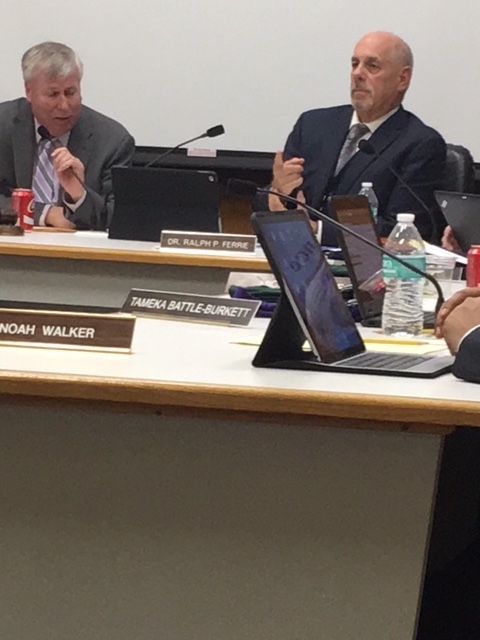By Samuel Glasser
The first draft of Sewanhaka Central High School District’s 2017-2018 budget shows a spending increase of 4.7 percent and a potential 4.76-percent increase in property tax revenue, district Superintendent Ralph Ferrie said Tuesday night.
“This is where we are now,” he said. “The projections are very fluid.”
The $192.8 million preliminary budget reflects an increase of $8.7 million over the current year.
Seventy-six percent of the increase reflects the first substantial payments that are coming due on the $86 million bond for capital improvements that voters approved in 2014.
The debt service payments are part of the operating budget and are excluded from the calculations of the district’s cap on property tax increases under state law, which is 4.76 percent.
“Voters in our district voted for us to spend $86 million to repair the schools so we wouldn’t have buckets in the hallway [to catch rainwater],” Ferrie said. Now, they need to approve a budget that includes repayment of the borrowed funds, he said.
Kevin O’Brien, Sewanhaka’s assistant superintendent for finance and operations, said the state’s cap on tax levy increases is based on a 2-percent increase or the consumer price index, a cost-of-living indicator, whichever is lower.
The current statewide cap for school districts is 1.26 percent, based on the consumer price index. Other factors are incorporated into a complex formula to determine each individual district’s cap.
Sewanhaka’s cap is 4.76 percent this year because excluded from the calculation are the debt on the bond and the separate $16.9 million energy performance contract, O’Brien said.
The district will need to make $2.3 million in cuts to stay within that cap, Ferrie said, adding that he would discuss the plan next week.
The district is aiming for “maintenance of the current staff” as it prepares for the cuts, Ferrie said.
“People always have in their head that it’s a 2 percent cap, but that’s just part of the calculation,” O’Brien said.
The energy improvements include rooftop solar panels, new energy-efficient lighting fixtures, gas conversions at two schools and new heating controls. The energy performance funds will be paid from the resulting energy savings and building-specific state aid, O’Brien said.
Sewanhaka is expected to receive $37.6 million in aid from the state, Ferrie said, an increase of $2.4 million.
“We hope the Legislature will give us more aid,” Ferrie said.
Current projections show a districtwide 66-student decline in enrollment next school year, Ferrie said.
The district’s contribution to the New York State Teachers Retirement System was projected to decline to 9.8 percent of payroll, down from the current level of 11.7 percent, Ferrie said.
But the district’s health insurance costs are increasing by 9.7 percent for 2017, he said.
The board has scheduled two other public budget meetings on March 8 and April 19 and a public hearing on May 9.
District residents will vote on the budget on May 16.



